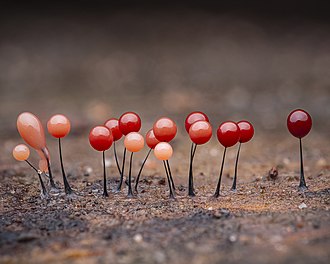
Back Slymvorme Afrikaans عفن غروي Arabic Слізевікі Byelorussian Sluzaste plijesni BS Fong mucilaginós Catalan Schleimpilze German Moho mucilaginoso Spanish Onddo lirdingatsu Basque کپک مخاطی Persian Myxomycètes French

Slime mold or slime mould is an informal name given to a polyphyletic assemblage of unrelated eukaryotic organisms in the Stramenopiles, Rhizaria, Discoba, Amoebozoa and Holomycota clades. Most are microscopic; those in the Myxogastria form larger plasmodial slime molds visible to the naked eye. The slime mold life cycle includes a free-living single-celled stage and the formation of spores. Spores are often produced in macroscopic multicellular or multinucleate fruiting bodies that may be formed through aggregation or fusion; aggregation is driven by chemical signals called acrasins. Slime molds contribute to the decomposition of dead vegetation; some are parasitic.
Most slime molds are terrestrial and free-living, typically in damp shady habitats such as in or on the surface of rotting wood. Some myxogastrians and protostelians are aquatic or semi-aquatic. The phytomyxea are parasitic, living inside their plant hosts. Geographically, slime molds are cosmopolitan in distribution. A small number of species occur in regions as dry as the Atacama Desert and as cold as the Arctic; they are abundant in the tropics, especially in rainforests.
Slime molds have a variety of behaviors otherwise seen in animals with brains. Species such as Physarum polycephalum have been used to simulate traffic networks. Some species have traditionally been eaten in countries such as Ecuador.